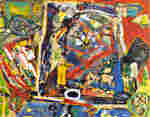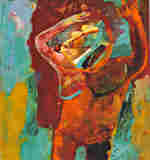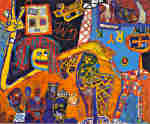George McNeil at Salander-O'Reilly Galleries
by Hearne Pardee

George McNeil: "Herbatim", 1987, oil on canvas, 78x98 in.

George McNeil: "Dancer #23", 1971, oil on canvas, 60x56 in.

George McNeil: "Resolution", 1980, oil on canvas, 68x56 in.

George McNeil: "Now Street #1", 1990, oil on canvas, 64x70 in.
Included in the survey of McNeil's work at Salander-O'Reilly were early abstract paintings and some of the heroic figures of the 1970s. Born of a rhythmic process, these often assumed the guise of dancers. Tokens of a process of transformation, they aim to escape convention, to court the grotesque, to pin down what de Kooning called a "slipping glimpse". McNeil's dancers and the questing figure of "Resolution" (1980) hark back to the founding impulse of abstract expressionism, to its search for the archetypal and mythic underpinnings of modern life.
A second room featured later figures from the 1980s, when McNeil achieved a virtuosic fluidity. McNeil finds symbolic potency in fluids - changeable, mutating. transformative; figures emerge in lush, liquid suspension, and they accumulate a welter of accessories related to the urban scene ("Herbatim", 1987). McNeil, who died in 1995, seemed exhilarated by pop vulgarity, and perhaps by the commercial success he enjoyed late in his life. "Now Street" (1990) adds graffiti and lettering to its collage-like mixture of vernacular imagery.
The figures in both phases of McNeil's art seem equally realized, fully embodied in painterly form. Both groups partake of their time and context. An innocent, celebratory impulse emerges in the later paintings - for all their Dionysian abandon, they have more in common with children's drawings than with de Kooning's more visceral women. The more austere early figures, on the other hand, distinguish themselves by a heroic dignity worthy of McNeil's isolated struggle to carry forward the legacy of modernism. In transforming the figure, McNeil elevates image-making, and the visual imagination, to a new level, and lends it a modernist pedigree.
Text copyright © 2005 Hearne Pardee
 back to Contents page
back to Contents page